The iPhone 5 Review
by Anand Lal Shimpi, Brian Klug & Vivek Gowri on October 16, 2012 11:33 AM EST- Posted in
- Smartphones
- Apple
- Mobile
- iPhone 5
General Purpose Performance
Section by Anand Shimpi
Apple's philosophy on increasing iPhone performance is sort of a mix between what Microsoft is doing with Windows Phone 7/8 and what the high-end Android smartphone makers have been doing. On the software side Apple does as much as possible to ensure its devices feel fast, although I notice a clear tendency for newer iOS releases to pretty much require the latest iPhone hardware in order to maintain that speedy feel over the long haul. When it comes to hardware, Apple behaves very much like a high-end Android smartphone vendor by putting the absolute fastest silicon on the market in each generation of iPhone. The main difference here is that Apple controls both the software stack and silicon, so it's able to deliver a fairly well bundled package each year. It's a costly operation to run, one that is enabled by Apple's very high profit margins. Ironically enough, if Apple's competitors would significantly undercut Apple (it doesn't cost $599 - $799 to build a modern smartphone) I don't know that the formula would be able to work for Apple in the long run (Apple needs high margins to pay for OS, software and silicon development, all of which are internalized by Apple and none of which burden most of its competitors).
Good cross platform benchmarks still don't really exist on smartphones these days. We're left describing experience with words and trying to quantify performance differences using web based benchmarks, neither of which is ideal but both of which will have to do for now. The iPhone 5 experience compared to the 4S is best explained as just being snappier. Apps launch faster, scrolling around iOS Maps is smoother, web pages take less time to load and the occasional CPU/ISP bound task (e.g. HDR image processing) is significantly quicker. If you're the type of person who appreciates improvements in response time, the iPhone 5 delivers.
How does it compare to the current crop of high-end Android smartphones? I would say that the 5 generally brings CPU performance up to par with the latest and greatest in the Android camp, and in some cases surprasses them slightly. It's difficult making cross platform comparisons because of huge differences in the OSes as well as separating out tasks that are CPU bound from those that simply benefit from a higher rendered frame rate.
I took a cross section of various web based benchmarks and looked at their performance to help quantify where the iPhone 5 stands in the world. First up are the RIABench focus tests, these are javascript benchmarks that focus on various compute bound tasks. I used Chrome for all Android devices to put their best foot forward.

This first test shows just how slow the 800MHz Cortex A9s in the iPhone 4S were compared to the latest and greatest from Qualcomm and NVIDIA. At roughly half the clock speed of those competitors, the 4S was just much slower at compute bound tasks. Apple was able to mask as much of that as possible with smooth UI rendering performance, but there was obviously room for improvement. The iPhone 5 delivers just that. It modernizes the iPhone's performance and inches ahead of the Tegra 3/Snapdragon S4 platforms. Only Intel's Atom Z2460 in the Motorola RAZR i is able to outperform it.
Next up is Kraken, a seriously heavy javascript benchmark built by Mozilla. Kraken focuses on forward looking applications that are potentially too slow to run in modern browsers today. The result is much longer run times than anything we've seen thus far, and a very CPU heavy benchmark:
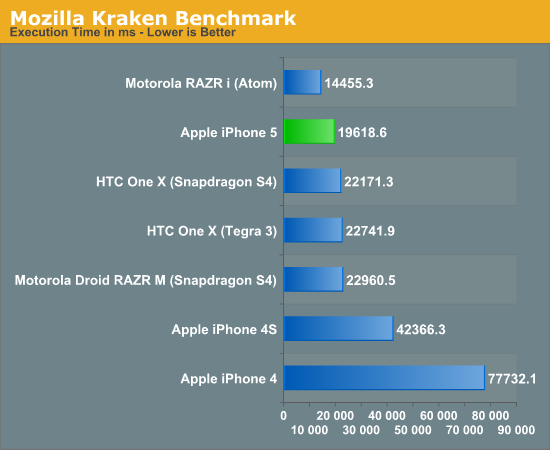
The standings don't change much here. The iPhone 4S is left in the dust by the iPhone 5, which steps ahead of the latest NVIDIA/Qualcomm based Android devices. The Apple advantage here is just over 10%. Once again, Intel's Atom Z2460 pulls ahead with the clear lead.
In our iPhone 5 Performance Preview we looked at Google's V8 javascript test as an alternative to SunSpider. The more data points the merrier:
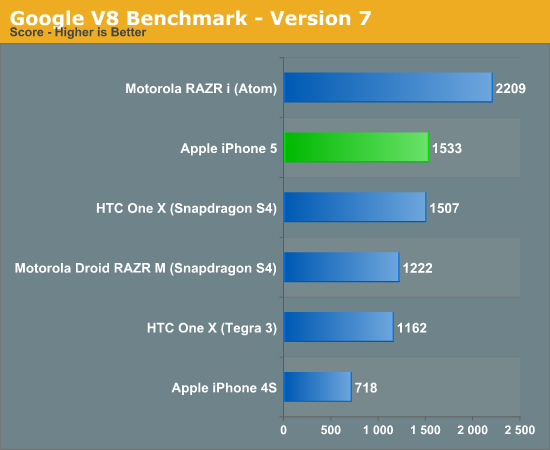
Here the iPhone 5 manages to hold onto its second place position, but just barely. Once more, the Atom based RAZR i maintains the performance lead.
Google's Octane benchmark includes all 8 of the V8 tests but adds 5 new ones including a PDF reader, 3D bullet physics engine and portable 3D game console emulator all built in javascript.
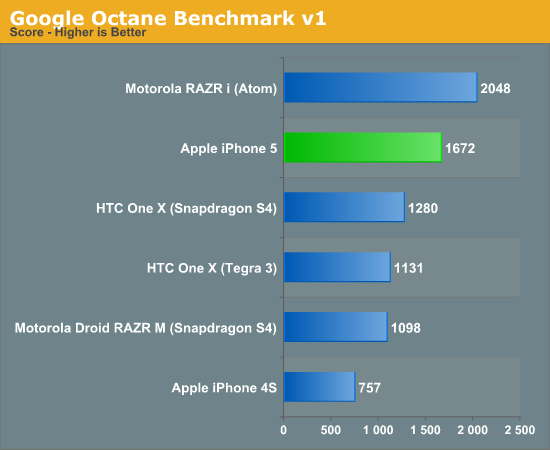
The 5 pulls ahead of the HTC One X here and maintains a healthy 31% lead, but once again falls short of the RAZR i.
We of course included our SunSpider and BrowserMark tests, both of which show the iPhone 5 very favorably:
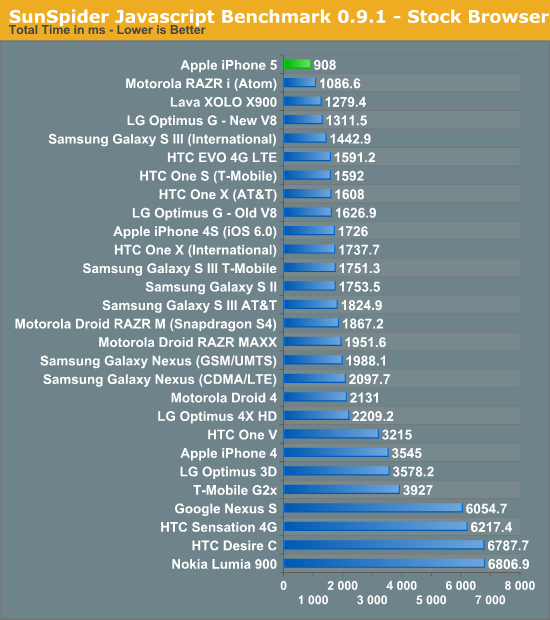
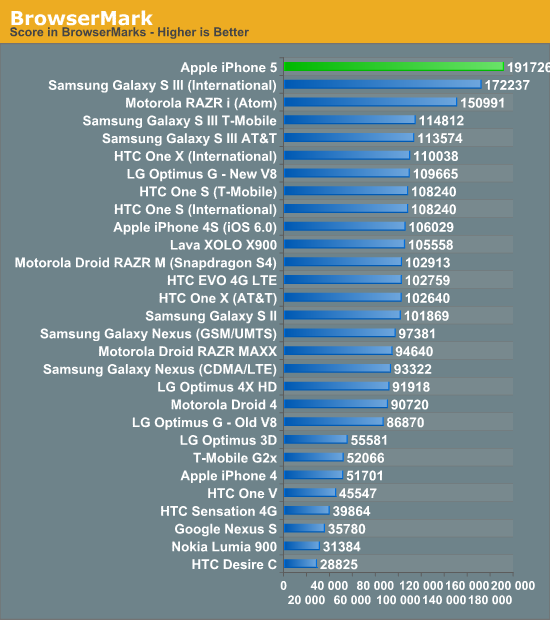
Performance obviously depends on workload, but it's clear the iPhone 5 is a big step forward from the 4S and tends to outperform the latest ARM based Android smartphones. As the rest of the ARM based SoC players move to Cortex A15 designs they should be able to deliver faster devices in the first half of 2013.
Intel's current position when it comes to CPU performance is interesting. A move to a dual-core design could be enough to remain performance competitive with 2013 ARM based SoCs. Remembering that Atom is a 5 year old CPU core that performs at the level of a 10 year old mainstream notebook CPU puts all of this progress in perspective. Intel's biggest issue going forward (other than getting Atom into more tier 1 phone designs) is going to be improving GPU performance. Luckily it seems as if it has the roadmap to do just that with the Atom Z2580.










276 Comments
View All Comments
A5 - Tuesday, October 16, 2012 - link
I don't think there's a good way to measure storage performance on the iPhone. Also not really sure why it matters.repoman27 - Tuesday, October 16, 2012 - link
I timed how long it took to transfer my music library, and clocked 11.1 MB/s writing to the user area of a 64GB model. So no significant change from previous iPhones, and still pretty typical for a smartphone. I'd be interested to get some gauge of the read speeds.And @A5, storage performance affects boot and application load times as well as sync and backup. With a 64GB model, syncing can take quite a while.
name99 - Wednesday, October 17, 2012 - link
Transferring the music library is a LOUSY choice for speed measurement because (depending on your iTunes settings) you may be transcoding all your music to a lower bit rate to fit more on the iPhone; so you are gated by the transcoding performance, not the flash write speeds. I transcode my music (most in Apple lossless on my iMac) to 192kbps AAC for my iDevices, and on my ancient iMac it is the transcoding that throttles performance.A much better situation to look at is transferring large movies. On my devices
- iPhone 4 writes at about 18MB/s
- iPad3 writes at about 22MB/s
Over the last 6 months Anand occasionally has published flash numbers for Android phones and they're generally around half these Apple numbers.
repoman27 - Wednesday, October 17, 2012 - link
Believe you me, I don't allow iTunes to transcode anything, except to ALAC on occasion. But yes, that number I gave was on the low side, but probably more due to it being thousands of files as opposed to one large sequential write.I just transferred a large video file back and forth directly to and from the user storage area of one of my apps, and came up with numbers that are more in line with yours. 23.84 MB/s avg read and 20.05 avg write.
Most MLC NAND modules capable of 20 MB/s writes should be able to do at least 40 MB/s on sequential reads, which leads me to believe that we're still gated to around 25 MB/s by the NAND interface here, which is kinda bogus.
Spunjji - Friday, October 19, 2012 - link
name99, that is not a "better situation" because the performance figures you quote only apply to large block file transfers. It's no more real-world than the figures repoman quoted, which are not "LOUSY". Both are valid, so ideally a proper test should mix both types of data.Furthermore, the idea that your admittedly ancient iMac being crap at transcoding MP3s somehow invalidates somebody else's testing is ridiculous as well. With any decent system that would only be the case if you were shifting data to a device a *lot* faster than any smartphone NAND.
So, you may need to rethink your "victory" a little more.
KPOM - Wednesday, October 17, 2012 - link
I've had my iPhone since 9/22 and there is not a single scuff on it. My guess is that in the rush, some units got through QC, but the phone itself isn't any more prone to scratching in normal use than other phones. Meanwhile, Apple being Apple, they have held up production to improve QC even if it means fewer sales in the short run.rarson - Wednesday, October 17, 2012 - link
You've had it less than a month. There shouldn't be any scuffs on it."Apple being Apple"
Ha! That's a good one!
Spunjji - Friday, October 19, 2012 - link
Trololololol"Mine is fine so everyone else is lying". <- Possibly my favourite bogus argument ever. Apple the generous indeed...
doobydoo - Saturday, October 20, 2012 - link
Because it's so much more compelling than the 'Mine is scratched so everyone elses must be'?lukarak - Wednesday, October 17, 2012 - link
But it doesn't rust. It scratches if it comes in contact with something harder. Just as a car does. Would you buy a car that gets a scratched bumper when you hit a wall? Well, maybe you wouldn't but people do. Regularly.This iPhone is no different than every other iPad, MBP or MBA or the first Al MB. Or any other device constructed from aluminium. They scratch if they are brushed against something. It's just normal.